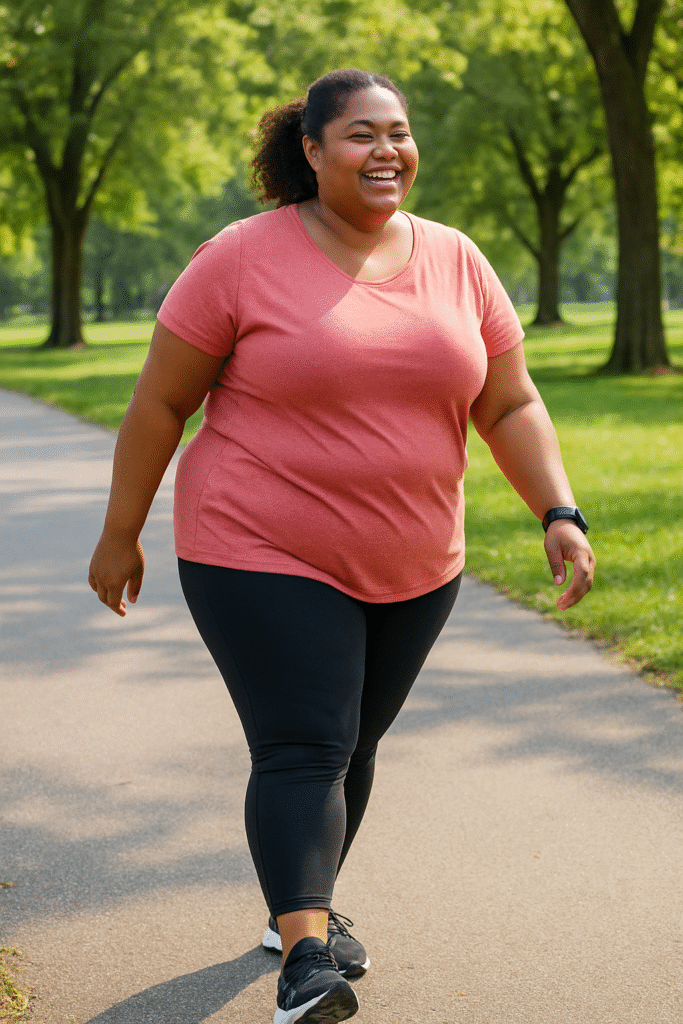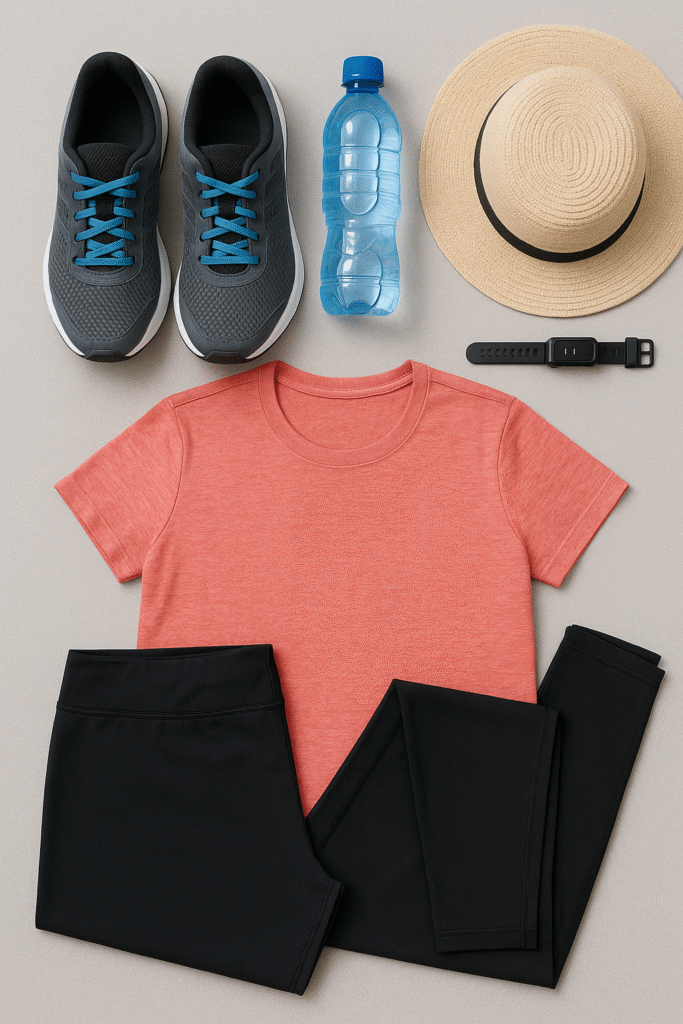Starting a fitness journey when you’re significantly overweight can feel overwhelming. Between gym intimidation, fear of injury, and conflicting advice, many people don’t know where to begin. But here’s the truth: you already have access to one of the most effective exercises available—walking.

Walking stands out as the perfect starting point for obese beginners because it’s free, accessible anywhere, and incredibly gentle on your joints. Unlike high-impact exercises that can strain your body, walking allows you to build strength and stamina gradually while minimizing injury risk.
Why Walking Works So Well for Weight Loss
Calorie Burning Made Simple
Walking burns approximately 200-300 calories per hour at a brisk pace (around 3 mph), with heavier individuals burning even more calories due to increased energy expenditure. This might not sound like much, but consistency matters more than intensity when you’re starting out.
Low-Impact, High Benefits
For individuals carrying extra weight, high-impact activities like jogging or jumping create excessive stress on joints—particularly the knees and hips. Each step while walking exerts only 1.5 times your body weight on your knees, compared to 3-4 times with running.
The Complete Health Benefits Package
Walking delivers far more than just weight loss:
Physical Benefits
- Cardiovascular Health: Strengthens your heart and improves circulation
- Muscle and Bone Strength: Builds endurance without overwhelming your joints
- Blood Sugar Control: Helps manage and prevent type 2 diabetes
- Immune System Boost: Regular walking strengthens your body’s defenses
Mental Health Benefits
- Improved Mood: Walking releases endorphins that naturally elevate your spirits
- Better Sleep: Regular activity helps regulate your sleep cycle
- Stress Reduction: Acts as a natural stress reliever
- Increased Energy: Paradoxically, expending energy through walking gives you more energy throughout the day
Safety First: Before You Take Your First Step
Get Medical Clearance
Before starting any exercise program, especially if you’re significantly overweight or have been inactive, consult with your doctor. This is particularly important if you have:
- Cardiovascular disease or high blood pressure
- Diabetes or pre-diabetes
- Joint problems (especially back, knee, or hip pain)
- Frequent shortness of breath or dizziness
- Any history of chest pain during physical activity
Your doctor can assess your current fitness level and provide personalized recommendations for safe exercise intensity.
Recognize Warning Signs
While minor muscle soreness is normal when starting a new activity, stop immediately if you experience:
- Sharp or persistent pain
- Chest pain or pressure
- Severe shortness of breath
- Dizziness or lightheadedness
- Nausea
- Rapid or irregular heartbeat
Remember: It’s better to start slowly and progress gradually than to push too hard and risk injury or burnout.
Your Walking Program: Starting Smart
Week 1-2: Building the Foundation
Frequency: 3-5 days per week
Duration: 10-20 minutes per session
Intensity: Comfortable pace where you can hold a conversation
If 10 minutes feels like too much, start with just 5 minutes. The goal is establishing the habit, not setting records.
Breaking It Down
Can’t find 20 minutes in one block? No problem. Three 7-minute walks throughout the day provide the same benefits as one 20-minute session. Try:
- A morning walk around your neighborhood
- A midday walk during lunch break
- An evening stroll after dinner
Sample Beginner Schedule
Day 1: 10 minutes steady walking
Day 2: Rest or gentle stretching
Day 3: 10 minutes with slight inclines if comfortable
Day 4: Rest or light activity
Day 5: 10 minutes with 1-minute intervals (alternate between moderate and slightly faster pace)
Day 6: 15-20 minutes at comfortable pace
Day 7: Rest
Progression Guidelines
Increase your walking duration by just 5 minutes every few days, or add 500-1000 steps weekly. This gradual approach prevents overuse injuries and keeps you motivated through achievable goals.
Important Rule: Increase duration and frequency before increasing intensity. Walk longer and more often before trying to walk faster.
🚶♂️ Walking Progress Tracker
Track your daily walks and celebrate every step forward
Weekly Goal: 0/150 minutes
Recent Walks
Essential Gear for Comfortable Walking

Footwear: Your Foundation
Proper shoes are crucial for preventing injury and ensuring comfort. Look for:
Key Features for Heavier Walkers:
- Strong arch support to prevent fallen arches and plantar fasciitis
- Ample cushioning (EVA midsoles work well)
- Comfortable, well-fitting design with room for toes
- Durable soles (Vibram rubber is excellent)
- Wide or extra-wide options if needed
Recommended Brands: Merrell, New Balance, Saucony, Skechers Performance, and ASICS all offer excellent options for heavier walkers.
Clothing That Works
Comfort Essentials:
- Moisture-wicking fabrics that draw sweat away from skin
- Fitted clothing that allows full movement without restriction
- Tights or spandex shorts to prevent inner-thigh chafing
- Supportive sports bra for women
- Layers for cold weather (you can remove as you warm up)
Sun Protection (for outdoor walking):
- Sunscreen (SPF 30 or higher)
- Hat or visor
- Protective clothing for extended exposure
Optional Support Accessories
- Water bottle: Essential for hydration, especially in warm weather
- Small backpack: For carrying essentials on longer walks
- Fitness tracker or smartphone app: Monitor progress and stay motivated
- Mobility aids: Canes, walkers, or rollators if needed for additional stability
Fueling Your Success: Hydration and Nutrition
Hydration Strategy
Daily Baseline: Aim for approximately half your body weight in ounces of water daily (200 lbs = 100 oz water)
Exercise Hydration Timeline:
- 2-3 hours before walking: 17-20 ounces of water
- 20-30 minutes before: 8 ounces
- Every 10-20 minutes during walk: 7-10 ounces
- Within 30 minutes after: 8 ounces
Hydration Check: Your urine should be colorless or light yellow—dark urine indicates dehydration.
Smart Nutrition Timing
Before Walking (2-4 hours prior):
- Whole grain cereals or toast
- Yogurt with fruit
- Banana or apple
Avoid before exercise: Heavy proteins and saturated fats, which digest slowly and can cause discomfort.
After Walking (within 2 hours):
- Combination of carbohydrates and protein
- Examples: yogurt with fruit, peanut butter sandwich, low-fat chocolate milk
General Nutrition for Weight Loss: Combine your walking program with a sustainable eating plan focused on:
- Abundant vegetables and whole fruits
- Whole grains (brown rice, oats, whole wheat bread)
- Lean proteins (fish, poultry, beans, nuts)
- Healthy fats (olive oil, avocados, fatty fish)
- Limited added sugars and processed foods
Advancing Your Walking Program
Month 2 and Beyond: Safe Progression
Once you've established a consistent routine, you can safely increase intensity through:
Faster Pace: Work toward a brisk pace where you can talk but not sing (approximately 3-4 mph)
Interval Training: Alternate 1-2 minutes of faster walking with 2-3 minutes of moderate pace
Hills and Inclines: Walking uphill activates three times more muscle fibers and burns up to 60% more calories than flat walking
Varied Terrain: Try grass, trails, or sand for increased resistance and muscle engagement
Stay Low-Impact: Continue avoiding high-impact activities like jogging until you've built significant endurance and received medical clearance.
Staying Motivated for Long-Term Success
Building Unbreakable Habits
Schedule Consistency: Walk at the same time each day to make it automatic Start Small: Better to walk 5 minutes daily than 30 minutes once a week Track Progress: Use apps or fitness trackers to monitor steps, distance, and improvements Find Accountability: Walk with friends, family, or join a local walking group
Making Walking Enjoyable
Engage Your Mind:
- Listen to music, podcasts, or audiobooks
- Practice mindfulness or meditation while walking
- Use walking time for planning or problem-solving
Vary Your Environment:
- Change routes regularly to prevent boredom
- Walk in different neighborhoods, parks, or trails
- Try indoor alternatives (malls, treadmills) during bad weather
Overcoming Common Challenges
Soreness: Minor discomfort is normal initially. Take rest days if needed, then resume at lower intensity.
Lack of Motivation: Remember that building habits takes time. Focus on small wins and celebrate every success.
Weather Obstacles: Have backup plans like indoor walking routes or home workout videos.
Plateaus: As fitness improves, your body adapts. Increase duration, add hills, or try new routes to continue progressing.
Missing Workouts: Don't get discouraged by occasional setbacks. Simply resume your routine as soon as possible.
Your Path Forward: Building Sustainable Success
Walking offers an accessible, safe, and effective foundation for your weight loss journey. By starting slowly, listening to your body, and gradually building intensity, you're setting yourself up for long-term success rather than quick burnout.
Key Takeaways:
- Start with just 10-20 minutes, 3-5 days per week
- Invest in proper footwear and comfortable clothing
- Stay hydrated and fuel your body appropriately
- Progress gradually—duration and frequency before intensity
- Make it enjoyable and build sustainable habits
Remember, the best exercise is the one you'll actually do consistently. Walking provides that perfect balance of effectiveness and sustainability that can transform your health one step at a time.
The journey to better health doesn't require expensive gym memberships or complicated equipment. It starts with putting one foot in front of the other. Your future self will thank you for taking that first step today.